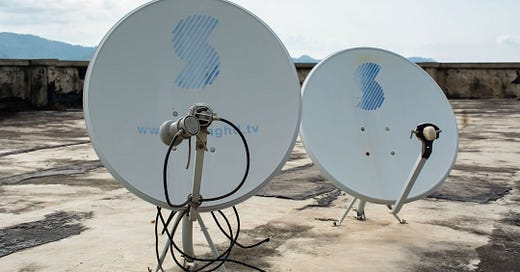Disclaimer: The following article provides a detailed analysis of the merger between DirecTV and Dish, facilitated by TPG. The information presented here is intended for informational purposes only and should not be construed as financial or investment advice. Readers are encouraged to conduct their own research and consult with qualified professionals before making any financial decisions.
Two of the largest players, DirecTV and Dish Network, are set to merge under the orchestration of private equity firm TPG. This landmark merger, pending regulatory approval, promises to reshape the landscape of pay-TV services in the United States.
Financial and Operational Aspects
The potential merger of DirecTV and Dish Network has been a topic of speculation for over two decades. Both companies first contemplated a merger in 2002, but the proposal was blocked by the Federal Communications Commission (FCC) due to antitrust concerns. At that time, the satellite television market was thriving, and concerns were raised that a merger would stifle competition and lead to higher prices for consumers.
Fast forward to the present, and the environment is markedly different. The rise of streaming services has profoundly impacted the traditional pay-TV industry. More consumers are opting to "cut the cord," favoring less expensive and more flexible streaming options over traditional satellite or cable TV. This shift has resulted in major subscriber losses for both DirecTV and Dish, setting the stage for a renewed merger proposal. The merger involves TPG acquiring the remaining 70% of DirecTV from AT&T for $7.6 billion and combining it with Dish Network, which has been grappling with a substantial debt load of $9.75 billion. This transaction aims to create a more formidable entity with a combined subscriber base of approximately 19.1 million, making it one of the largest pay-TV providers in the nation.
AT&T's decision to sell its stake in DirecTV marks its complete exit from the television business, allowing the telecom giant to concentrate on its core areas, such as wireless 5G and fiber connectivity. This pivot is intended to enhance AT&T's balance sheet and better position the company in a rapidly evolving telecommunications landscape. For Dish Network, the merger represents an opportunity to alleviate its financial burdens while also enabling EchoStar, Dish’s parent company, to focus on emerging technologies like Open RAN 5G. By divesting its TV operations, EchoStar can allocate more resources towards innovations that promise to drive future growth.
Regulatory Environment
Given that the FCC blocked the previous merger attempt in 2002, regulatory approval remains a critical hurdle for this deal. However, the current market dynamics differ considerably from those two decades ago. The dominance of streaming services owned by tech giants like Netflix, Amazon, and Disney has diluted the market power once held by satellite TV providers. Consequently, the competitive landscape may encourage regulators to view the merger favorably.
MoffettNathanson analyst Craig Moffett suggests that the likelihood of regulatory resistance is low given the current market context. He argues that while potential synergies between DirecTV and Dish are limited due to their distinct satellite technologies, the merger could still provide benefits by reducing customer churn and operational costs. The merger's potential impact on the satellite television industry is multifaceted. By combining resources, DirecTV and Dish aim to offer a more competitive service in an industry increasingly dominated by streaming options. This consolidation could lead to cost savings that are ultimately passed on to consumers, although the extent of these savings remains uncertain.
For consumers, the merger could mean access to a broader range of programming and potentially improved service offerings. However, there are concerns that reduced competition might lead to higher prices in the long run, particularly for consumers in rural areas who rely more heavily on satellite services due to limited broadband access. The merger highlights the ongoing transformation within the media landscape. As traditional media companies seek to adapt to the digital age, consolidations like that of DirecTV and Dish could become more common, reshaping how content is delivered and consumed.
The merger of DirecTV and Dish Network reflects broader trends within the media and telecommunications industries. As companies navigate the challenges posed by digital disruption, consolidations offer a pathway to remain relevant and competitive. However, the ultimate success of this merger will hinge on regulatory approval and the companies' ability to integrate their operations effectively.
The ramifications for consumers and the industry at large are noteworthy, heralding a new era in the evolution of television services. As DirecTV and Dish embark on this ambitious merger, stakeholders across the spectrum will be watching closely to assess its impact on the future of satellite television.
Disclaimer: This article is intended for informational purposes only and does not constitute financial or investment advice. Readers should seek professional guidance before making any financial decisions.
We are working endlessly to provide free insights on the stock market every day, and greatly appreciate those who are paid members supporting the development of the Stock Region mobile application. Stock Region offers daily stock and option signals, watchlists, earnings reports, technical and fundamental analysis reports, virtual meetings, learning opportunities, analyst upgrades and downgrades, catalyst reports, in-person events, and access to our private network of investors for paid members as an addition to being an early investor in Stock Region. We recommend all readers to urgently activate their membership before reaching full member capacity (500) to be eligible for the upcoming revenue distribution program. Memberships now available at https://stockregion.net




